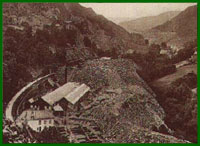
 |
|
| |
King
Arthur's
Labyrinth
History and Archeology
Slate mines were opened in Corris in 1836, but for many years they were uneconomic and a series of companies went bankrupt. Then in 1859 the narrow gauge Corris Railway was built to carry the slate down to the Dyfi estuary and the future of the Braich Goch Slate Quarry Company, formed in 1864, was assured.
 The
Miners drove their tunnels deep into the hillside to reach the so-called
Appendix Vein of high quality Ordovician slate. From these access tunnels
they drove at right angles into the vein and mined a series of chambers
up to 50 metres wide and 25 metres high, leaving pillars to support the
roof. By 1878 the quarry employed 250 men and produced 7,000 tons of slab
and roofing slate a year and the company prospered. But eventually rising
costs and falling demand forced the company to collapse in 1906. Five
further companies intermittently attempted to work the mine but failed
to make a profit and they all failed. Then, in 1962, Dewi and Gwilym Lloyd
of Aberllefenni bought the mine to extract high quality slate slabs for
electrical fittings and worked the mine for eight years. However, in 1970
a new road scheme for the A487 brought about the closure of the slate
mill and the levelling of the slate tips. The Corris Craft Centre was
then built on the reclaimed land and opened in 1983.
The
Miners drove their tunnels deep into the hillside to reach the so-called
Appendix Vein of high quality Ordovician slate. From these access tunnels
they drove at right angles into the vein and mined a series of chambers
up to 50 metres wide and 25 metres high, leaving pillars to support the
roof. By 1878 the quarry employed 250 men and produced 7,000 tons of slab
and roofing slate a year and the company prospered. But eventually rising
costs and falling demand forced the company to collapse in 1906. Five
further companies intermittently attempted to work the mine but failed
to make a profit and they all failed. Then, in 1962, Dewi and Gwilym Lloyd
of Aberllefenni bought the mine to extract high quality slate slabs for
electrical fittings and worked the mine for eight years. However, in 1970
a new road scheme for the A487 brought about the closure of the slate
mill and the levelling of the slate tips. The Corris Craft Centre was
then built on the reclaimed land and opened in 1983.
King Arthur's Labyrinth was opened in 1994, necessitating the flooding of part of the network of roadways to create a river access to the Labyrinth. The boat now takes visitors along the old Level-6 tramway that was opened around 1950. The Chambering of the higher Level 5 can be seen above the Dinas Emrys chambers, while the Bran and Cantre'r Gwaelod chambers are linked behind the pillar to form a continuous roof of 50 by 100 metres, which is the size of a football pitch.
| Geology >> |